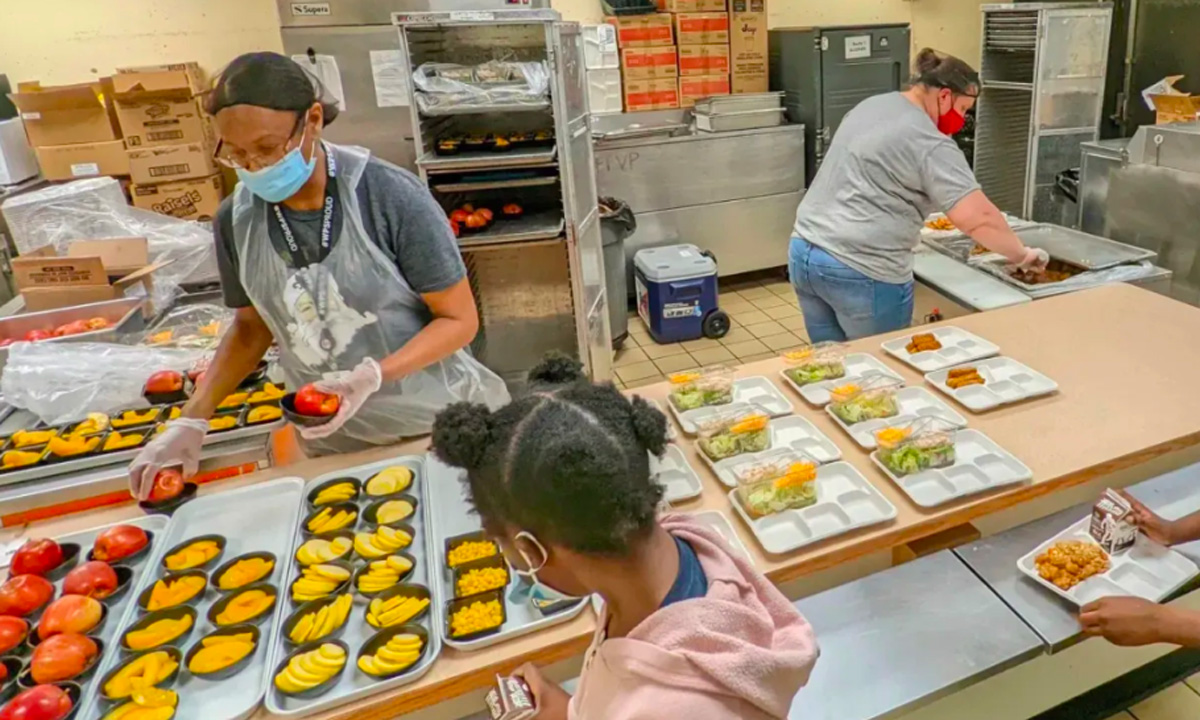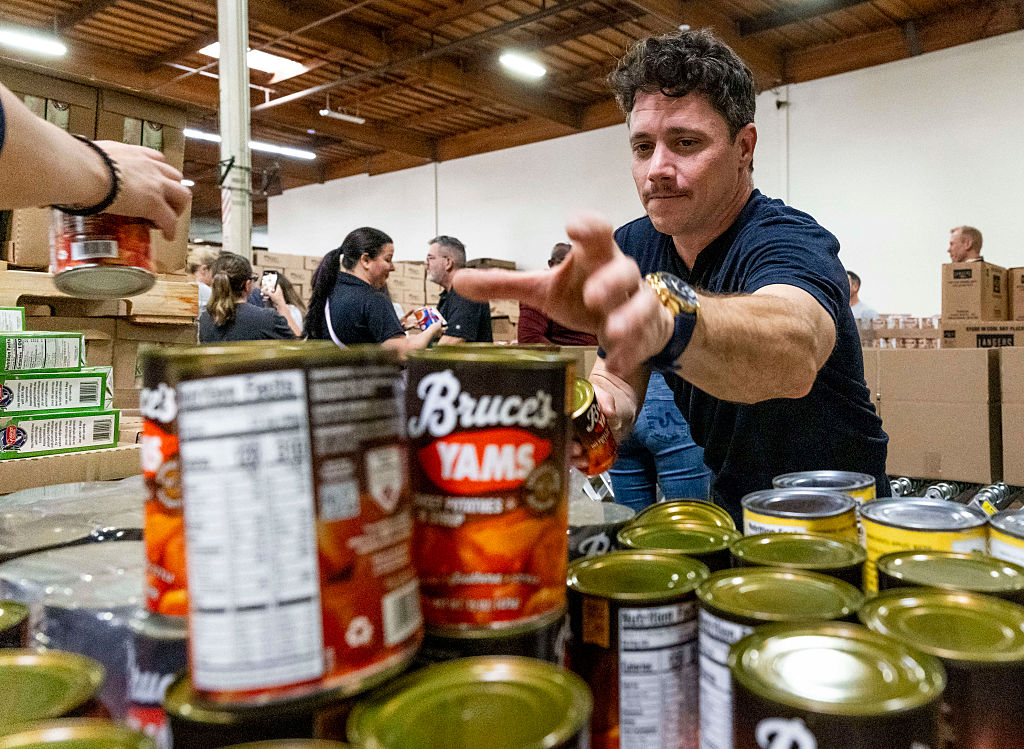Fears Big Beautiful Bill Will Leave Both Cupboards and School Lunch Trays Empty
Tax bill will cut SNAP by $186B, pushing families off food assistance and making it harder for schools to offer universal free meals, experts say.

Get stories like this delivered straight to your inbox. Sign up for The 74 Newsletter
Correction appended July 14
Barren cupboards at home during the summer. Empty stomachs at school in the fall. Advocates predict that may soon be the reality for many of the nation’s children after passage of the One Big Beautiful Bill Act, which calls for dramatic cuts in federal food aid.
Signed into law July 4 by President Donald Trump after squeaking through the House and Senate, the massive bill will reduce funding to the Supplemental Nutrition Assistance Program, known as SNAP, by roughly $186 billion — approximately 20% — between 2025 and 2034. And new rules are expected to make it harder for needy families to obtain the aid.
The result: Some 5 million people will lose at least some benefits, including 800,000 children, according to the Center on Budget and Policy Priorities, a nonpartisan research and policy institute.
The controversial bill, which delivers tax breaks to the wealthy, comes just a few months after the agriculture department slashed more than a billion dollars from programs that allowed schools and food banks to buy locally produced goods.
And it arrives at the same time that 13 GOP-led states, including Texas, are pulling out of summer meal programs, rejecting federal dollars to feed children during the months when they are most vulnerable, citing administrative costs and other reasons.
Erin Hysom, senior child nutrition policy analyst at the Food Research & Action Center, said the cuts and eligibility changes to SNAP — the deepest since its 1939 founding as the food stamp program — put students’ well-being and education at risk.
“Children’s learning will be disrupted and their health will be jeopardized,” she said. “It’s really going to be devastating. Every state will be affected by this.”
Currently, people without dependents are limited to three months of SNAP benefits in a three-year period unless they work at least 80 hours per month and continue to do so until age 54. The new law extends that work requirement to age 64.
Under current rules, SNAP recipients responsible for a child under 18 are exempt from the work rule. The new bill reduces the cutoff age to 14.

Mia Ives-Rublee, senior director for the Disability Justice Initiative at The Center for American Progress, a left-of-center think tank, said the work-related rules, which require extensive documentation, will pose an administrative hurdle some families might not overcome.
“A lot of people who get cut off from these services are people who are working but don’t have the time or energy to fill out all of this paperwork,” she said.
But perhaps the most significant change to SNAP is a shift in financial responsibility for the program from the federal government to the states. All 23 Democratic governors warned Congress in June that they were unprepared to shoulder this new financial burden — some noted they might have to withdraw from the program completely — and food banks are already overwhelmed.

Child and family health advocates were relieved to see at least one of their fears was not realized: The Community Eligibility Provision, which reimburses tens of thousands of schools that provide free breakfast and lunch to all students, was expected to lose billions. Those changes were not included in the bill’s final version.
SNAP eligibility among children is a trigger for schools to provide free meals. As fewer kids qualify for food aid at home, those children will not get the nutrition they need and their classmates will also lose access, advocates say.
“As SNAP enrollment drops, fewer schools will be able to offer all students free meals,” Hysom said. “So, we’ll see a rise in stigma in the cafeteria, a decrease in school meal participation, the return of school meal debt for many schools and increased hunger in the classroom.”

Rev. Dr. Starsky Wilson, president and CEO of the Children’s Defense Fund, is worried about the kids who will be pushed out of the program despite their ongoing food insecurity, noting that children of color might be disproportionately impacted.
Wilson said schools moving toward universal free meals in recent years — delivered without students having to apply — was a positive development. The changes brought about by the new bill mark a major step backward, he said.
“We believe we will see a shift back to an individual eligibility model, which costs more and means fewer students will have access to it,” he said.
Beginning in fiscal year 2028, any state that has a payment error rate — the percentage of people given benefits who did not qualify or who were denied aid despite meeting the requirements — between 6% and 8% must contribute a 5% match for the cost of SNAP program allotments.
State contributions rise incrementally as the error rate increases: those reaching 10% or higher will be required to kick in 15%, though questions loom about how this will be implemented. Some states with high error rates might not have to pay as soon as others.
The paperwork requirement is not only burdensome for families, but for those who process the documents, child advocates say. The task comes as the federal government also plans to drastically reduce what it spends on SNAP’s administrative costs, from 50% to 25%, leaving states responsible for the rest.
Gina Plata-Nino, the Food Research & Action Center’s deputy director for SNAP, fears states will not be prepared to properly administer the benefit program.
“This will cost state agencies a lot of time — and time is money,” she said, adding new applicants might have to wait to be processed. “The state agencies are already at capacity.”
Plata-Nino said the related calculations will be more complex, especially for families with children.
The bill also eliminates SNAP-Ed, an evidence-based program that “helps people make their SNAP dollars stretch, teaches them how to cook healthy meals, and lead physically active lifestyles,” according to the USDA.
Correction: An earlier version of the story incorrectly reported that the bill changed the work exemption for able-bodied adults with children from those with dependents under age 18 to those with kids under 7. The reduction to age 7 was in the House version of the bill, but was changed to age 14 in the Senate version that was ultimately approved.
Get stories like these delivered straight to your inbox. Sign up for The 74 Newsletter

;)
